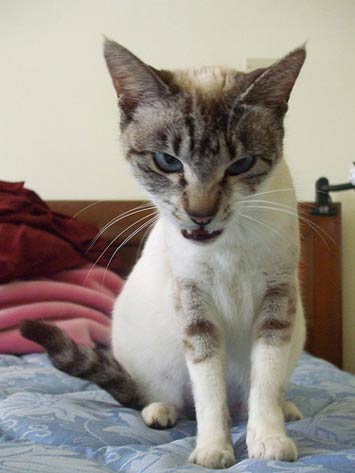DAMN IT: The Pet-Saving Acronym
No, I’m not having an especially bad day. I just recently had a case that made me remember the DAMN IT acronym that I frequently used as a new graduate from veterinary school. As I’ve gained more experience, I’ve not turned to it as much, which has probably not been to the benefit of my patients.
Recently I saw an 18-year-old kitty that had been diagnosed with renal failure about a year ago and was being treated for it, albeit not very aggressively. She had been doing well until recently, when she started to strain to have a bowel movement, had blood in her stool, was not eating well, and was somewhat lethargic. The owner basically told me that she didn’t want to do any more diagnostic testing, but if I could come up with a reasonably-priced treatment plan based on the findings of a physical exam only, she’d consider that option instead of euthanasia.
Arrg! The list of this kitty’s potential problems was pretty long. Were the difficult to pass hard stools the result of dehydration brought on by worsened renal failure? Could she have megacolon, parasites, or maybe even an intestinal foreign body? The physical exam was pretty unremarkable: tiny kidneys, an empty colon, a nonpainful abdomen, mild dehydration, and nothing else of too much interest. That’s when I thought "DAMN IT" (for more than one reason, in this case).
Veterinarians use the DAMN IT acronym to help recall all the potential causes of a pet’s symptoms and to narrow down the list of possible underlying problems. This is essential to developing an efficient plan for diagnosis and treatment.
Each letter stands for a couple (or more) disease categories, for example:
D = Degenerative or Developmental
A = Anomalous or Autoimmune
M = Metabolic, Mechanical, or Mental
N = Nutritional or Neoplastic
I = Inflammatory, Infectious, Ischemic, Immune-mediated, Inherited, Iatrogenic, or Idiopathic
T = Traumatic or Toxic
As long as I systematically think through every category, the chances that I’ll overlook a disease that has a high probability of being to blame for a pet’s symptoms are much lower than they would be otherwise.
In my patient’s case, my best educated "guess" based on her physical exam, lifestyle, and history was that her renal failure needed to be treated more aggressively. So, I increased the amount of subcutaneous fluids she was getting, changed her diet, and encouraged her owner to make sure she was giving the gastroprotectants and stool softeners that had been previously prescribed on a regular basis. This treatment plan had the additional benefit of potentially treating some of the other conditions on my list and, at the very least, doing no harm.
So the next time you hear your veterinarian muttering "Damn it, D… Degenerative, Developmental; A… Anomalous…" you can rest assured he or she is not having a breakdown.

Dr. Jennifer Coates
Pic of the day: suki by nicki191286

